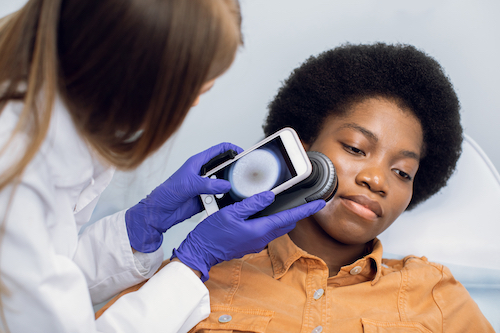Dermatological Diseases
Dermatological diseases—also referred to as skin diseases and conditions—are quite common and becoming more prevalent as the population ages. In fact, in a report published by the American Academy of Dermatology, it was found that more than 85 million people in the U.S. alone are impacted by skin diseases and conditions.1
Skin is the Largest Organ of the Human Body
The body’s skin is its largest organ. It—along with nails, hair, oil/sweat glands— make up the integumentary system, i.e., the set of organs that form the outermost layer of the body.
Skin provides a stable, yet flexible, protective barrier against harmful environmental factors. It is composed of three main layers: the hypodermis (bottom layer), dermis (middle layer) and epidermis (top layer).

The hypodermis:
- The fatty layer
- Helps to regulate body temperature
- Cushions bones and muscles
The dermis:
- Grows hair
- Produces sweat
- Supplies blood (via blood vessels) to the epidermis
The epidermis:
- Keeps bacteria and germs from entering the body
- Contains melanin, the pigment that gives skin its color
- Generates new skin
Skin Diseases & Conditions
The severity of skin diseases and conditions varies. Some are long-lasting, some are temporary and some can be life-threatening.
Four Common Skin Diseases & Conditions
- Eczema (also called atopic dermatitis)—causes the skin to become itchy, dry and red.
- Psoriasis—causes itchy, scaly patches of skin typically on knees, elbow and scalp.
- Warts—occurs when a virus infects the skin.
- Cold sores (also called fever blisters or herpes labialis)—small blisters that typically form on the lips or skin around the mouth.
- Acne—occurs when hair follicles are plugged with dead skin cells and oil.
Life-threatening Skin Diseases & Conditions
Skin cancer is one of the most common cancers in the United States,2 and current estimates indicate that one in five Americans will develop skin cancer in their lifetime.3
Skin cancer is a rapid, abnormal growth of cells in the epidermis. It’s caused by unrepaired damage to the DNA that triggers mutations and multiplies skin cells, ultimately resulting in the formation of malignant tumors. The main cause of skin cancer is overexposure to harmful ultraviolet (UV) rays.
While skin cancer is the most prevalent of serious skin diseases and conditions, there are several rare yet just as serious conditions that can have life-altering impacts.
Five of these conditions are:
- Pemphigus vulgaris: An autoimmune disease that causes blisters on the skin and mucous membranes throughout the body.
- Stevens-Johnson syndrome (SJS): Often begins with flu-like symptoms, followed by a red or purple rash that spreads and forms blisters. SJS is typically caused by an adverse reaction to medication.
- Toxic epidermal necrolysis: A life-threatening skin disorder that causes the skin to peel in sheets, leaving large, raw areas of the body exposed and susceptible to infection.
- Toxic shock syndrome: A sudden and potentially fatal condition caused by bacteria getting into the body and releasing harmful toxins. Symptoms include a red, flat rash that covers most of the areas of the body and shedding of the skin in large sheets, especially over the palms and soles.
- Staphylococcal scalded skin syndrome: A disorder that develops because of a toxin produced by a staphylococcal infection. It gives the skin an appearance that it has been burned or scalded and causes it to peel off in large sheets.
Dermatology
Dermatology is the branch of medicine that deals with the skin. Dermatologists are skin surgeons and medical doctors who specialize in the study, diagnosis and treatment of conditions associated with the skin, nails and hair.
Dermatological specialists include:
- Dermatopathologist—specializes in dermatology and pathology. These specialists diagnose cutaneous diseases by examining biopsied skin samples.
- Mohs surgeon—Mohs surgery is a technique used to treat skin cancer. It’s a process in which thin layers of skin are removed and examined until cancer cells can no longer be seen.
- Pediatric dermatologist—specializes in treating infants and children with severe and/or rare skin conditions.

Digital Dermatology
As with all other fields of medicine, dermatology is also continually evolving thanks in part to technology. Digital dermatology has found a role in almost every aspect of dermatology4 and is revolutionizing the way that conditions are discovered, diagnosed, treated, and even prevented.
Mobile health apps are an important part of digital dermatology. In fact, a total of 526 dermatology mobile apps were found corresponding to an 80.8% growth in dermatology apps since 2014 and the market share of teledermatology increased from 11.0% in 2014 to 20.1% in 2017.5
These apps are used around the world and make it easier, faster and more convenient for people to do a number of beneficial things, including:
References
- Lim, Henry W et al. The burden of skin disease in the United States. Journal of the American Academy of Dermatology vol. 76,5 (2017): 958-972.e2.
- Guy, Gery P Jr et al. Prevalence and costs of skin cancer treatment in the U.S., 2002-2006 and 2007-2011. American journal of preventive medicine vol. 48,2 (2015): 183-187. doi:10.1016/j.amepre.2014.08.036
- Stern, Robert S. Prevalence of a history of skin cancer in 2007: results of an incidence-based model. Archives of dermatology vol. 146,3 (2010): 279-82. doi:10.1001/archdermatol.2010.4
- Glines, Katelyn R et al. “Digital future of dermatology.” Dermatology online journal vol. 26,10 13030/qt75p7q57j. 15 Oct. 2020
- Flaten, Hania K et al. Growth of mobile applications in dermatology - 2017 update. Dermatology online journal vol. 24,2 13030/qt3hs7n9z6. 15 Feb. 2018

